Hosta spp.
It’s easy to see why hostas are some of the most popular perennials on the market. They’re practically foolproof to grow; come in a massive array of sizes, patterns, and colors; and can adapt to a range of conditions.
Yes, they are beloved for their foliage, but they also send up spikes of flowers that are sometimes heavily scented and can be quite showy.
The tall flower spikes rise above the foliage in shades of purple, pink, red, yellow, lavender, and white. The flowers are actually quite pretty, even though they don’t get as much recognition as the leaves.
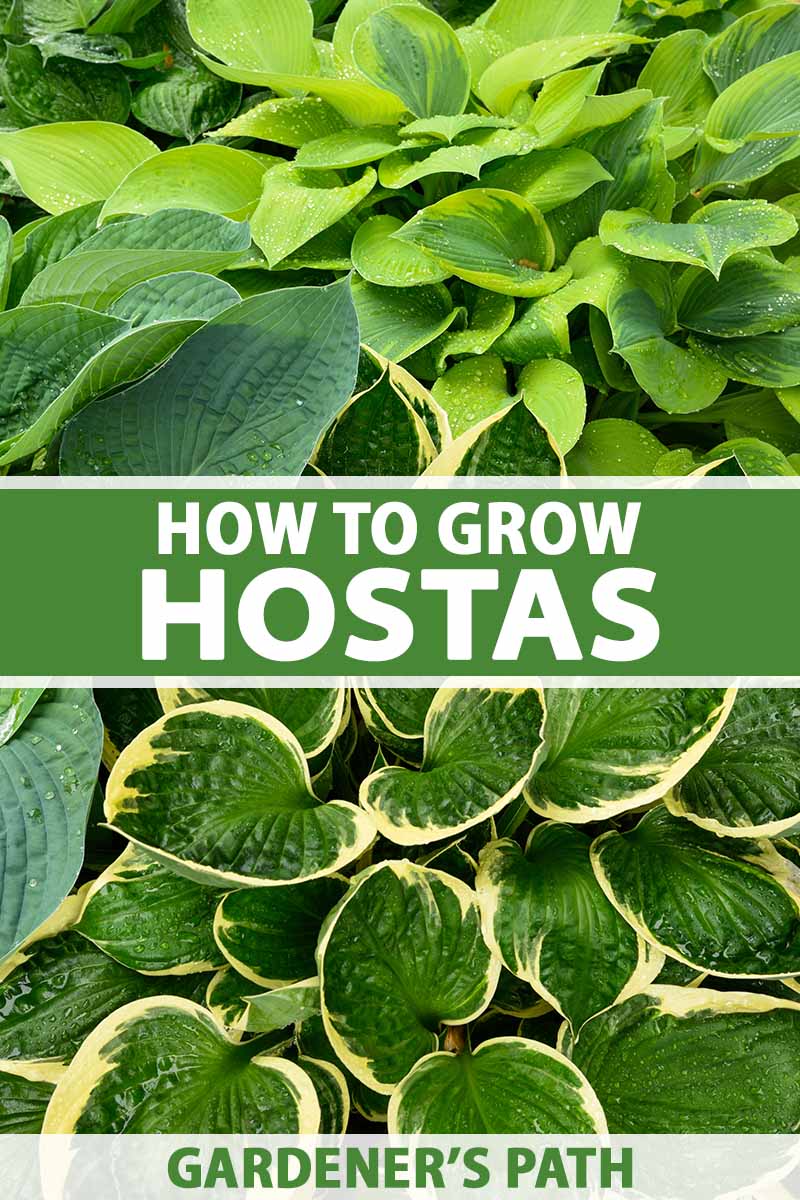
We link to vendors to help you find relevant products. If you buy from one of our links, we may earn a commission.
The flowers are especially noticeable when a particular cultivar is planted in mass groupings.
Whether you need a little help with your existing hostas or you’re looking for something new for your space, we’ve got your back. Here is what we’ll cover in this guide:
What You’ll Learn
Are you ready to get started? Let’s say “hello” to hostas!
Cultivation and History
Hostas have been cultivated in China, Japan, and Korea, where they grow natively, for centuries.
They’ve been around so long that they are one of the oldest perennials out there. In the 1700s, they were imported to Europe where cultivation efforts expanded.
From there, they traveled across the Atlantic to the United States. The first mention of hostas in the US was in 1839, in The American Flower Garden Directory.
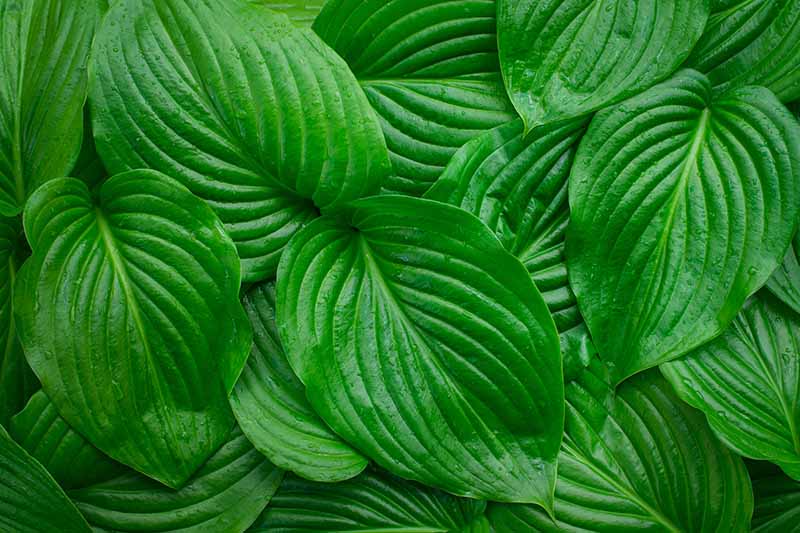
Today, there are 42 recognized species, and over 8,000 named cultivars and hybrids. Most hail from plants that originated in Japan.
Back in the day, they were called plantain lilies or funkias, but you rarely hear those names these days.
Hostas are incredibly varied. The texture of the leaves can be glossy, waxy, matte, or anything in between.
Leaves range from totally smooth to heavily wrinkled. The foliage can be nearly white to deep dark green or even blue, and may have yellow, cream, white, or gold accents.
They can be solid, striped, mottled, spotted, or splotched. Leaf margins can be smooth, wrinkled, or serrated.
Leaf size can be small or up to two feet long, and the shapes can be lance-like to nearly round.
Typically, the stalk (called the petiole) that the leaves are attached to is medium green or creamy green, but some new hybrids have petioles that are red or even spotted.
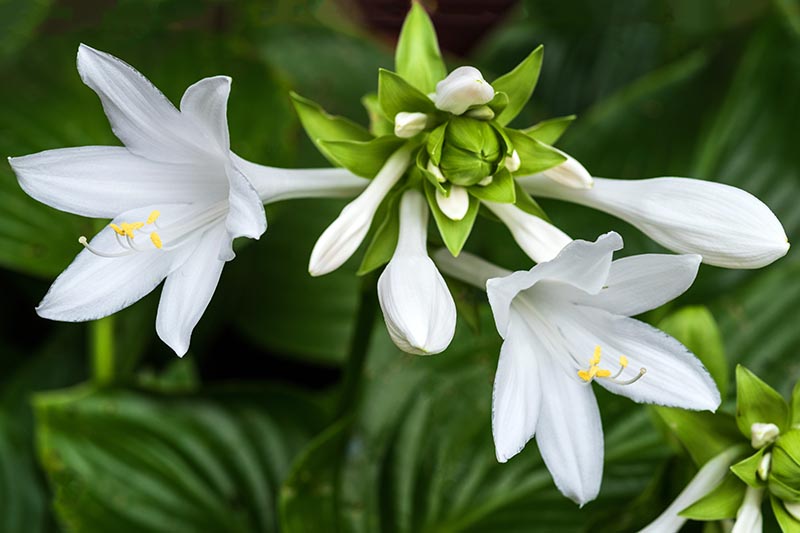
And that’s just the leaves and stems! Then there are the flowers.
Blossoms range from white to dark lavender, and every shade of purple or pink in between. There are even a few cultivars with red blossoms, and one with yellow (‘Miracle Lemony’).
The flowers can range from nearly insignificant to large and showy, and heavily fragrant or nearly scent-less.
Shapes include trumpet (tubular), bell, or spider, and they can be single or double. Some breeders are even currently trying to create varieties with massive, lily-like blossoms.
Plants can bloom starting in the late spring to fall, depending on the variety, and last for weeks.
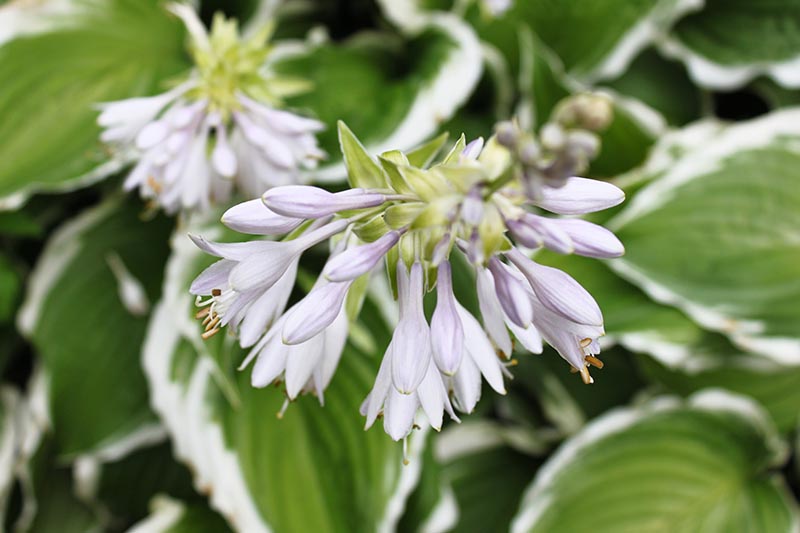
Hosta plantaginea, which the species most often referred to as plantain lily even today, has the most fragrant flowers.
The flower stalks can be cream-colored or green, and there are even a few with red stalks.
We discuss hosta flowers in more detail here.
And the variety doesn’t stop there. There are cultivars that only spread a few inches wide, while others spread up to eight feet or more.
The American Hosta Society groups these plants into five sizes: giant (greater than 28 inches tall), large (18 to 28 inches tall), medium (10 to 18 inches tall), small (six to 10 inches tall), and miniature (less than six inches tall).
Most hostas stay the same color from spring to fall, but some show something called “viridescence,” and will transition to a darker color in the fall.
Leaves that show “lutescent” transition from green to yellow. “Ablescent” foliage turns from yellow to white over the growing season.
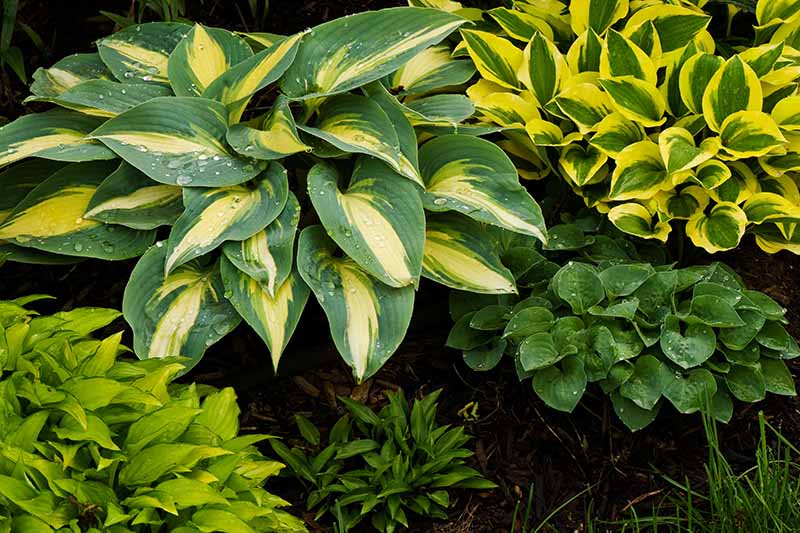
When it comes to variegation, there are a few different types. Medio variegated plants have light green, yellow, gold, cream, or white at the center of the leaf.
Leaves that are marginally variegated show their color at the edges. Streaked or splashed variegation shows up as random streaks of a lighter color on a dark base.
Growth habits can be mounded, upright, or rhizomatous.
These plants can adapt to a range of conditions, from nearly full shade to full sun, and moist to dry soil.
The big leaves almost make them resemble a tropical plant, but they are decidedly not of this variety. They need a dormancy period to survive.
This dormancy period can’t occur in the most southern zones of semi-tropical regions. For this reason, the hosta is classified as hardy from USDA Hardiness Zones 2 to 7, and it is sometimes listed as hardy to Zone 8 for certain varieties.
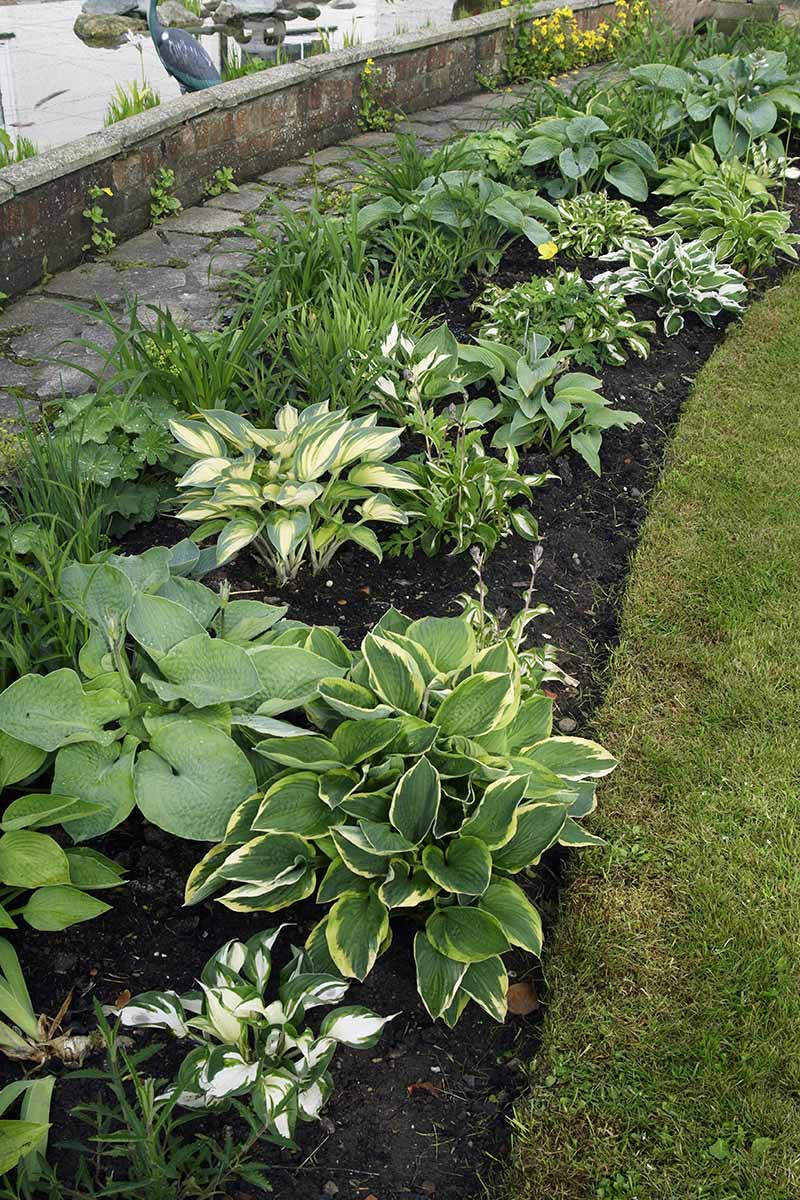
Finally, before we move on to our recommendations for growing this fabulous plant, let’s take a quick snack break.
You might not realize that when you’re strolling past a big clump of hostas on your evening walk, you’re actually passing a real delicacy.
It’s a testament to how stuck we are in our ways that most people don’t appreciate their value as veggies.
Hostas are edible, from the end of their roots to the tip of their flower stalks, and everything in between. However, the best part to eat is the young shoots.
These have a flavor that many people describe as asparagus-like, but I think they taste better than most varieties of asparagus out there. I’d say the flavor is more like a cross between a rich, green lettuce such as romaine, and a stalk of asparagus.
If you didn’t harvest and eat the shoots while you had the chance, the young leaves, young stems, and flowers are all incredibly tasty as well. They have less of that umami-rich asparagus flavor, but they are equally excellent.
The people of Japan call edible hosta parts urui, and they eat the stalks, shoots, leaves, and flowers in many preparations – boiled, fried, and raw.
Growers there heap mulch (usually rice husks) around the stalks to blanch them as they grow, and make them even more palatable. More American growers need to catch onto this tradition!
By the way, while you might want to tuck into a plate of hosta goodness, don’t let your canine or feline companions do the same. Hostas are poisonous to dogs and cats, and can cause vomiting, diarrhea, depression, and even death.
Propagation
Hostas typically grow via underground rhizomes, though some species have fibrous roots.
Regardless, all of them can be propagated by division, or you can purchase transplants or bare root plants. Some can even be grown from seed.
The best time to plant is in the spring or fall.
From Seed
Almost all varieties that are available commercially won’t grow true from seed, which is why most types that are sold are propagated through tissue cultures or divisions. However, H. ventricosa plants can be grown from seed.
To plant seeds of this type, amend your soil if needed (we’ll talk about the ideal soil in the following section) and then sprinkle the seeds onto moistened ground when average air temperatures are between 60 and 75°F. Lightly cover with soil.
Keep the earth moist as the seeds germinate, which takes a week or two, depending on the conditions.
From Divisions
Hostas divide well, so if you or a friend have an existing plant, you can divide it and spread the beauty.
Dividing can be done at any time of year when the soil can be worked, but spring or fall is best. If you divide in the spring, wait until the eyes (those little growing tips) have emerged from the earth.

There are two ways to divide your plants:
The first is to dig up the entire plant and cut it down the middle with scissors or pruners, or into thirds or quarters if it’s large.
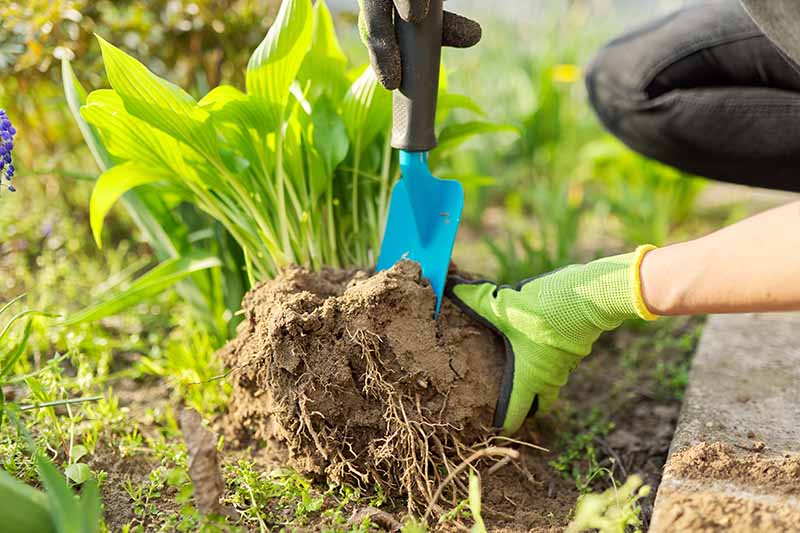
Or, you can dig out a clump of the plant and leave the rest in the ground. You can use a garden knife to create a division and then use a shovel to lift that section out.
Either way, you need to include a bit of the crown and roots of each section in order for it to survive. Plant as you would a transplant, as described below.
Keep the divisions well-watered for the first month. You’ve reduced the root structure, so the leaves aren’t being fed as much moisture as they’re used to.
Find more tips on dividing hosta plants here.
From Transplants
If you opt to purchase starts at a nursery, the planting process is pretty straightforward.
Gently remove the plant from its container by grabbing the plant around the base and working it out. Loosen the roots and shake away any excess soil.
Dig a hole that is slightly larger and deeper than the container the plant was growing in. Put the hosta into the ground so that it sits at the same level it was growing at in the container.
Gently tamp soil around the plant to fill in the rest of the hole, and water well to settle it.
Get more tips on transplanting hostas here.
From Bare Roots
If you order your plants online or from a catalog, you’ll usually receive bare root hostas.
These can be planted as you would live transplants, but you’ll need to soak them in room temperature water for at least an hour before you plant them.
How to Grow
Although hostas can tolerate some sun, most cultivars require a certain amount of shade, especially from the hot afternoon sun.
The summer climate varies quite a lot between the northern and southern parts of the United States. This should be taken into consideration when choosing a planting location.
These plants actually suffer more from the extreme heat of southern zones, and therefore need more shade and water if planted there.
If you live in a northern area or a region that doesn’t become particularly hot, hostas can be planted in a spot with partial sun. In hotter areas, they will need more shade.

Keep in mind that though they are known as shade-lovers, most hostas don’t grow well in deep, dark shade. They need a little bit of dappled sunlight or early morning sunshine to thrive and look their best.
Hostas grow slowly, and the plants will be smaller than they would be otherwise if they are placed in deep shade.
All that being said, the amount of sun your plant should receive will depend on the species, hybrid, or cultivar you select.
For instance, blue varieties do better in cooler regions and in more shade than others.
You can grow them in partial shade (not full sun), but the blue color will tend to fade because the sun dries up the waxy coating that gives the leaves that blue hue. If you want something for a full shade area, blue hostas are the way to go.
Plantaginea hybrids can tolerate more sun than others, and some of them do well in full, direct sun. Plants with yellow or gold coloring do better in part sun. Anything shadier, and the color will probably look more green than yellow.
Variegated varieties usually do better in partial shade. Too much sun and they’ll burn. That’s okay, because they are ideal to liven up a dark area with their patterned leaves.
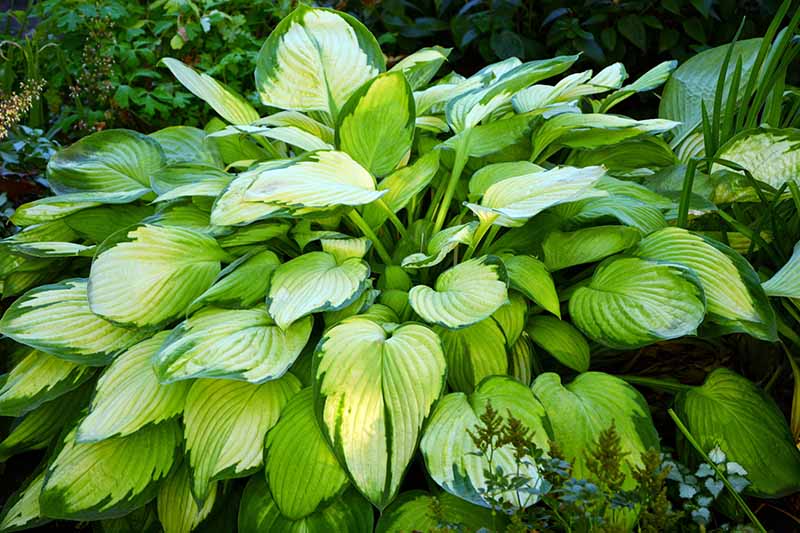
Montana and plantaginea hybrids don’t do well in northern areas because they emerge in the early spring and can be killed off by late frosts.
Since they flourish in shade, the usual recommended planting location is under trees. The only problem with this is competition with the surface roots of large shade trees.
Sometimes the tree roots can deplete all of the water and nutrients from the soil. This makes growing plants directly in the root zone difficult.
Just place your plants far enough away from the surface roots to avoid compromising their health.
And don’t worry about planting around juglone producing trees like black walnut. Hostas are immune to juglone (a natural herbicide).
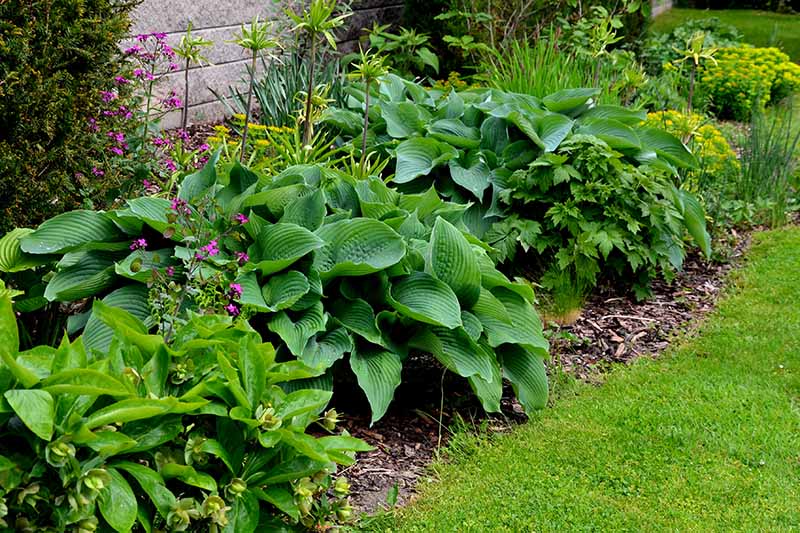
The soil should have a pH right around 6.5 to 7.5, and should retain water without draining poorly. Hostas can handle moist conditions, but standing water around the roots isn’t ideal.
I’m going to assume that, like most of us, you don’t have perfectly loamy, fertile, well-draining yet still-water-retentive soil. In that case, dig down 16 inches and amend the soil with well-rotted compost.
If you have heavy clay, your best bet is to plant in a raised bed or a container.
By the way, those big, beautiful leaves come with a cost. Because the leaves are so large, the plants lose a lot of water through respiration. To compensate for that, they need a good amount of moisture in the soil.
They prefer constantly moist soil, but not standing water.
Plants should be given about an inch of water per week, so if you don’t receive that much rain, you’ll need to provide supplemental water – a rain gauge can help you to figure this out. In hotter areas like the south, you might need to provide more water.
If the leaf tips start wilting, add more water. A layer of mulch can help the soil to retain moisture. Use about an inch of compost, wood chips, or aged manure.
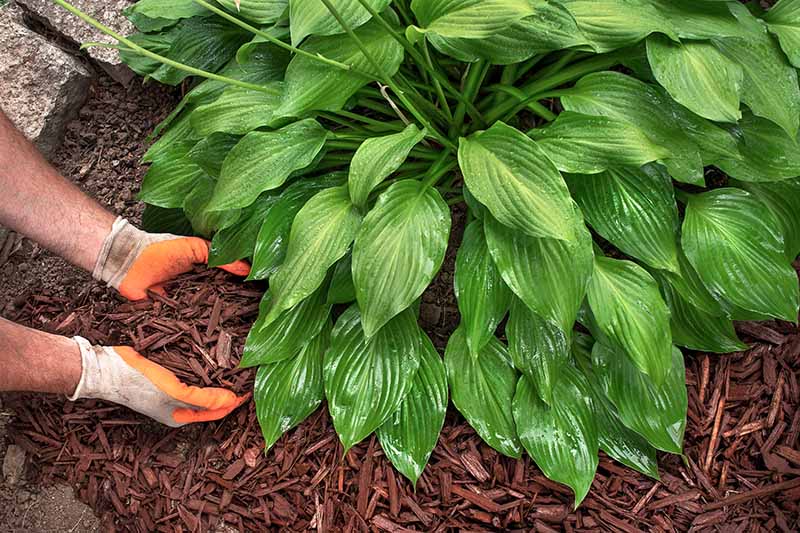
If hostas get too dry too often or for too long, the margins of the leaves might turn brown and dry. Plants may also grow more slowly or to a smaller size than they would otherwise.
Hostas are ideal plant companions for spring bulbs such as daffodils, tulips, crocuses, snowdrops, and trilliums.
They begin to emerge at about the same time. The hosta’s leaves will help to hide the bulbs’ foliage when it becomes unsightly after blooming.
The leaves also contrast well with astilbes, ferns, hellebores, and snakeroots.
The size of these plants can vary quite a lot. It’s important to know the mature size of the cultivar you’ve selected, to make sure you give it enough room in the garden.
It’s easy to make a mistake when planting a new unfamiliar variety and to find yourself being forced to move it very soon, as has been my personal experience.
These plants will continue getting larger in the first few years. Many won’t reach their mature size for about four years, and some cultivars take even longer, up to eight years.
The foliage forms a tidy clump that will only become more attractive as it ages.
Fertilizing
Provide some light fertilizer once per year, in the spring when the leaves have pushed through the soil and are near their full size.
Use a balanced slow-release product such as Osmocote’s Smart Release Plant Food, which is designed to be used on almost any type of plant.
Osmocote’s Smart Release Plant Food
Home Depot carries this product in two-pound bottles.
Alternately, use a fish emulsion soil soak once a month, starting after the leaves have emerged from the soil.
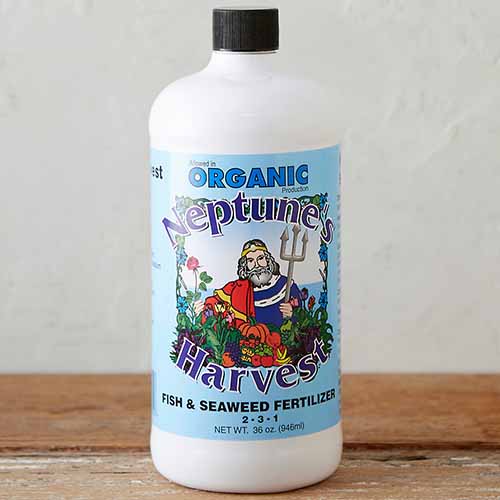
Neptune’s Harvest Fish and Seaweed Fertilizer
Neptune’s Harvest makes a good option, and you can purchase it at Terrain.
Container Growing
Hostas of all sizes do well in containers, but you have to remember that these plants like a lot of water, and containers tend to dry out faster than the ground soil does.
As such, you must keep an eye on your plants to make sure that they aren’t drying out too quickly.

This planting method allows for their location to be changed as often as desired.
The size of the container depends on the size of the plant – not the ultimate size, but the current size. You should allow about three inches of space between the plant and the edge of the container.
Each year, you’ll either need to divide the plant and put it back in the same size container (with fresh soil, of course) or go up one container size to repot.
Some slower-growing varieties might not need to be repotted or divided every year, but most do.
Fill your containers with an all-purpose potting mix designed to retain water. You can also use a general all-purpose mix and add some rice hulls to help improve water retention.
Potted plants need some winter protection in the form of pine boughs or a tarp, or choose a type that can grow in an area that is at least one zone colder than where you live.
If you live in Zone 5, for example, choose a plant that’s hardy down to Zone 4 to ensure that it’s able to make it through the winter.
Find more tips on growing hostas in containers here.
Growing Tips
- Keep the soil moist but not wet.
- Sun exposure depends on the type, but most need partial sun or partial shade.
- Fertilize in the spring, after the leaves have emerged.
Pruning and Maintenance
Hostas are incredibly low maintenance. You often hear of easy-care plants described as something along the lines of “plant and forget it,” but hostas truly fit this description, for the most part.
You don’t have to divide them regularly, but feel free to do so if you want to expand your garden.
If your hostas aren’t sending up flower stems, have no leaves in the center, or if they are growing too big for their spot, divide away. Do this in the spring, as the leaves are forming.
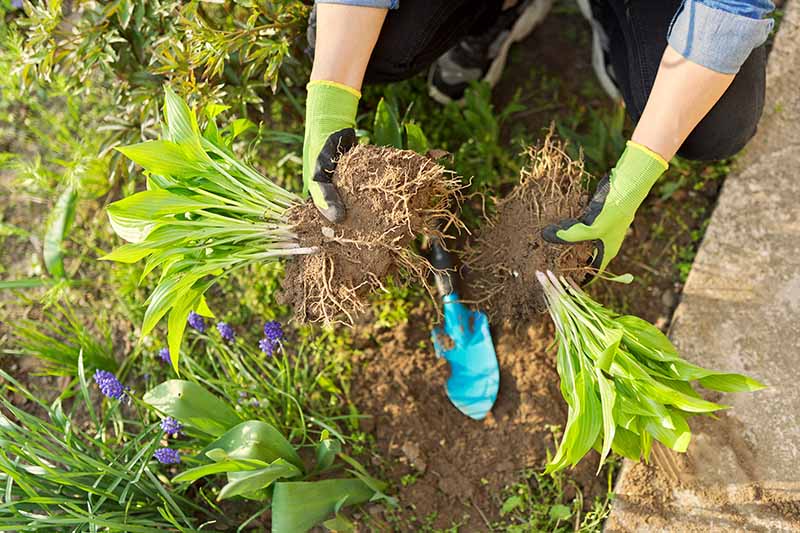
Cut off the flower spikes (known as racemes) after they have faded.
Some gardeners advocate for cutting the leaves down to the ground in the winter. This creates a cleaner look in the garden, but some experts suggest that it’s better to let the leaves remain in place.
The leaves provide winter protection, help to retain soil moisture, and can encourage the plants not to emerge too early the following spring.
That said, foliage that remains in place can spread disease and encourage pests.
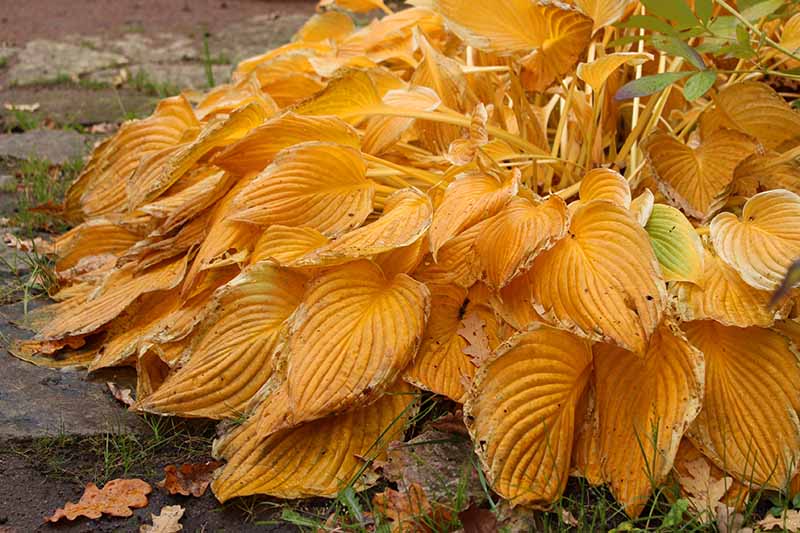
If you have had problems with pests or diseases, it’s probably best to remove the leaves. On the other hand, if you struggle with voles, early emergence, or winter kill, consider leaving the foliage in place.
Alternatively, you can heap pine boughs around the plants to protect them during the winter. That way, you can get the best of both worlds.
In general, hostas planted in the ground don’t need winter protection. Young plants can benefit from a layer of mulch to help retain moisture and prevent heaving. Remove the mulch in the spring.
During particularly hot spells, provide your hostas with some extra protection, and consider misting the leaves in the morning.
Make sure they stay well-watered. Hostas are prone to heat dormancy, which is when a plant goes dormant because of heat stress.
If hail damages the leaves, remove any shredded or holey leaves. New foliage will grow and replace the damaged stuff.
Cultivars to Select
Leaf size and texture can vary among the many cultivars available. There are dwarf varieties with leaves only about one inch wide, while others have leaves that are more than 15 inches wide.
The leaf texture can be smooth or heavily crinkled, much like seersucker fabric. The variegated color patterns on the leaves of various cultivars are numerous as well.
If you want a hosta that can handle full sun, pick ‘August Moon,’ ‘Fragrant Bouquet,’ ‘Guacamole,’ ‘Fried Green Tomatoes,’ or ‘Sum and Substance.’
I think ‘Sum and Substance’ is a reliable must-have, plus it grows four-foot-tall spikes covered in large purple blossoms. If you agree, you can pick one up at Nature Hills Nursery.
Hostas for nearly full shade include ‘Autumn Frost,’ ‘El Niño Green,’ ‘Empress Wu,’ ‘Gold Standard,’ and ‘Wheee!’
By the way, that last, adorably-named plant is also available at Nature Hills Nursery in #1 containers, if it sounds like the right plant for your garden.
If you’re interested in hostas for the flowers, ‘Regal Splendor’ has lavender, bell-shaped blossoms on scapes that can reach up to 60 inches tall in the right conditions.
‘Guacamole’ and ‘Fragrant Bouquet’ have intensely fragrant, large, white blossoms.
If you’re a fan of award-winners, hosta lovers at the American Hosta Society (AHS) voted ‘Blue Mouse Ears’ as one of the best cultivars out there for several years in a row.
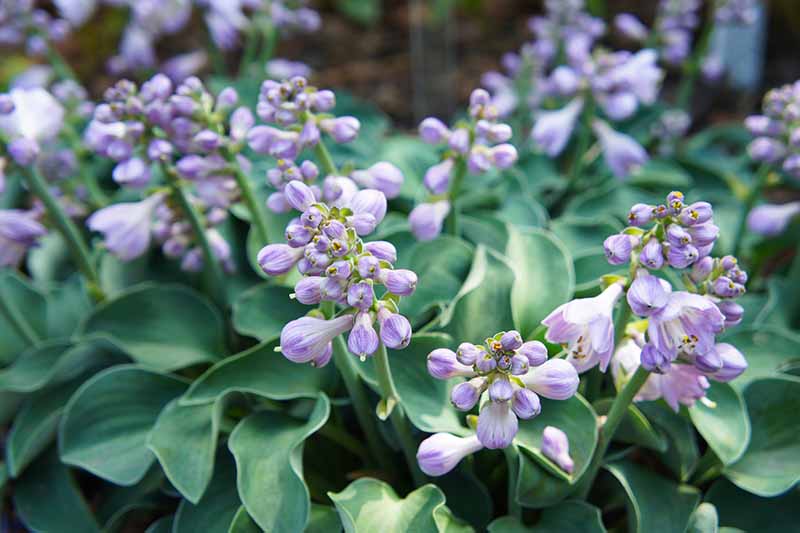
‘June’ was voted hosta of the year in 2001 by the AHS, while ‘Sagae’ nabbed the honor in 2000. ‘Krossa Regal’ has been a best-seller on the market for years.
We have an entire guide to help you pick the perfect hostas for your garden. Be sure to check it out for more options.
Managing Pests and Disease
Part of what makes growing hostas so easy is that there are very few pests and diseases that impact them seriously. There are a few herbivores that will munch on them, however. Here’s what you need to keep an eye out for.
Herbivores
Hostas are, unfortunately, a favorite snack for several types of herbivores. They’ll chomp away happily if the opportunity presents itself – especially if other food is scarce. Here are the big three:
Deer
Deer won’t pass up the opportunity to dine on your hostas – the big leaves must look like a big, inviting salad buffet to them.
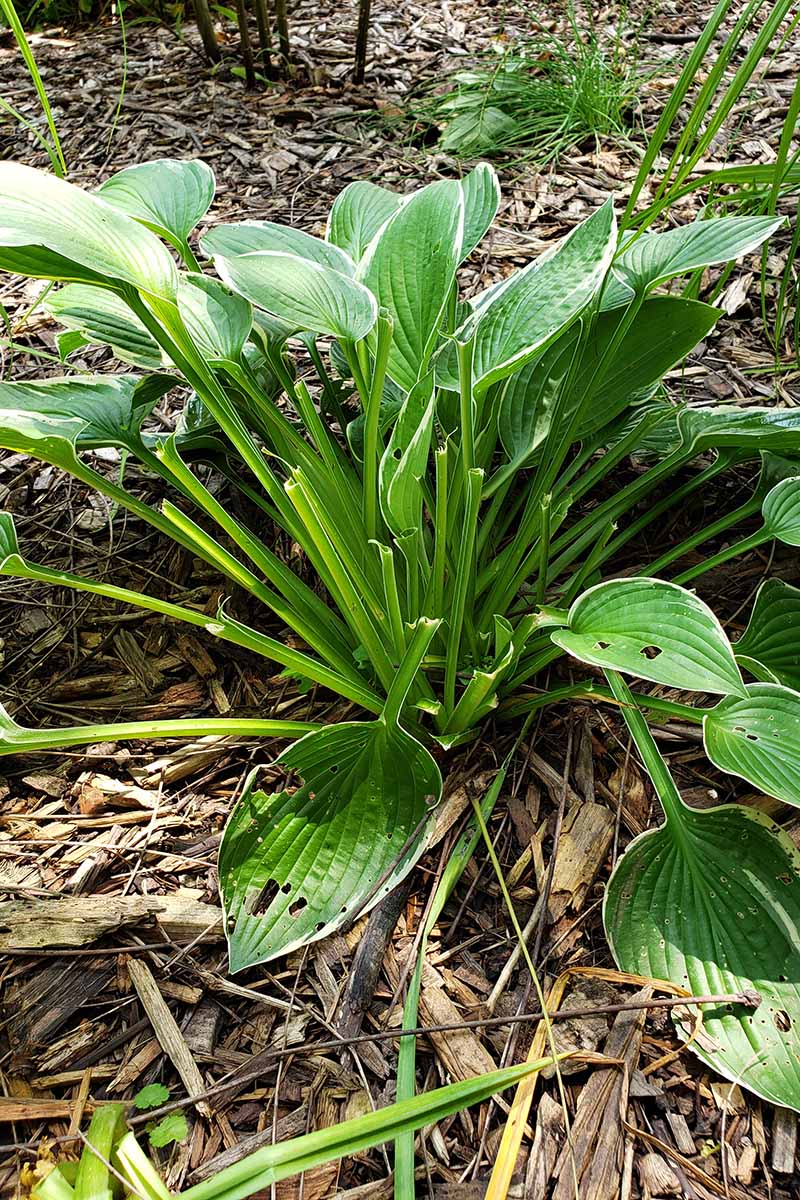
If you have deer in your area, chances are those hungry ungulates will have a go at your plants at some point.
We have a helpful guide to help you deer-proof your garden. If you want a solution to protect your entire garden, you might consider fencing.
Deer chomp hostas down to the top of the stalks of the leaves (petioles), and they’ll eat the flower stalks as well. The deer prefer young leaves, but they’ll eat older leaves if nothing better is around.
Flowers, however, are always fair game, whether they are young buds or fully mature blossoms.
Most hostas will come back later in the same year or the following year, so don’t pull them if the deer get to them.
It’s best to leave the plants alone, so don’t prune them any further or try to divide them if they’ve incurred deer damage. You can buy deer-resistant varieties, but they are only slightly more deer resistant than other types.
Rabbits
Like deer, rabbits love hostas too. They might just take a nibble here and there, or they can devour an entire plant.
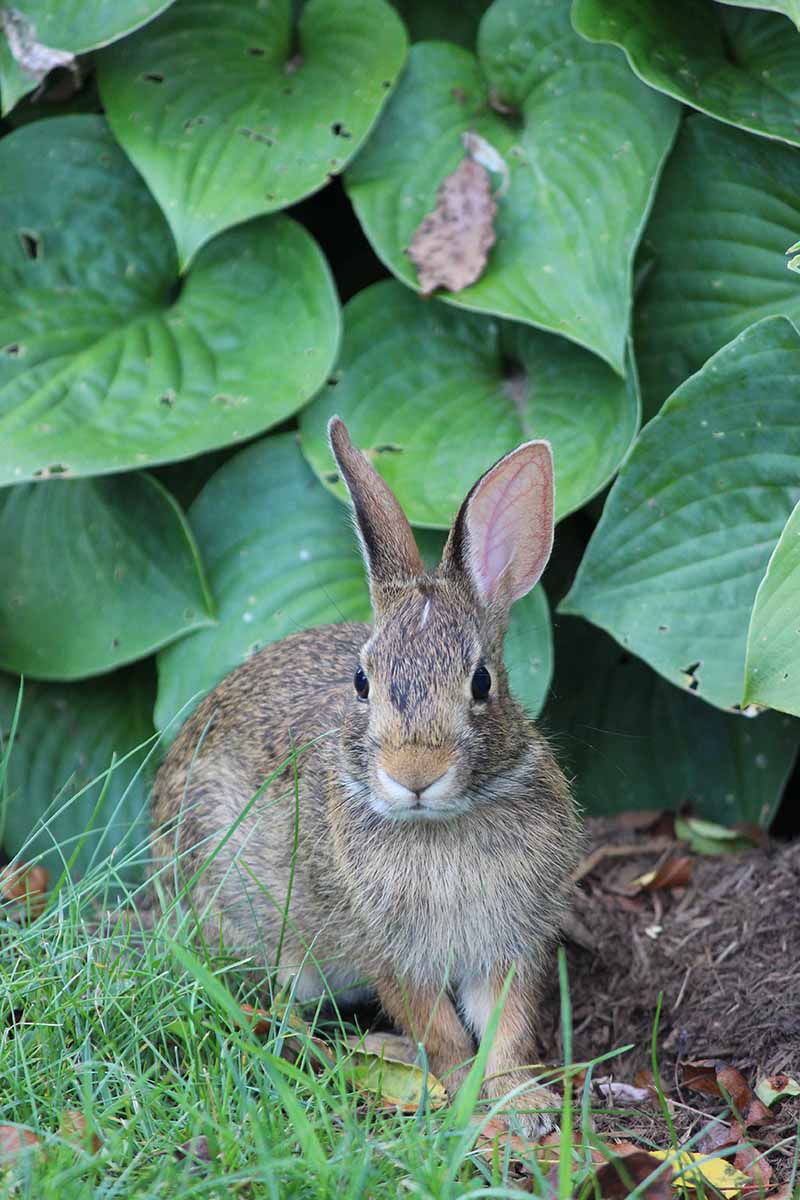
Young or small ones are particularly at risk. But don’t worry, we have lots of tips to help you keep the rabbit situation under control.
Voles
Voles eat the roots of hostas, and more than rabbits or even squirrels (who are opportunists and will dig up or nibble on very young plants), these rodents have the potential to completely kill your plants because they destroy the root structure underground before you realize what’s happening.
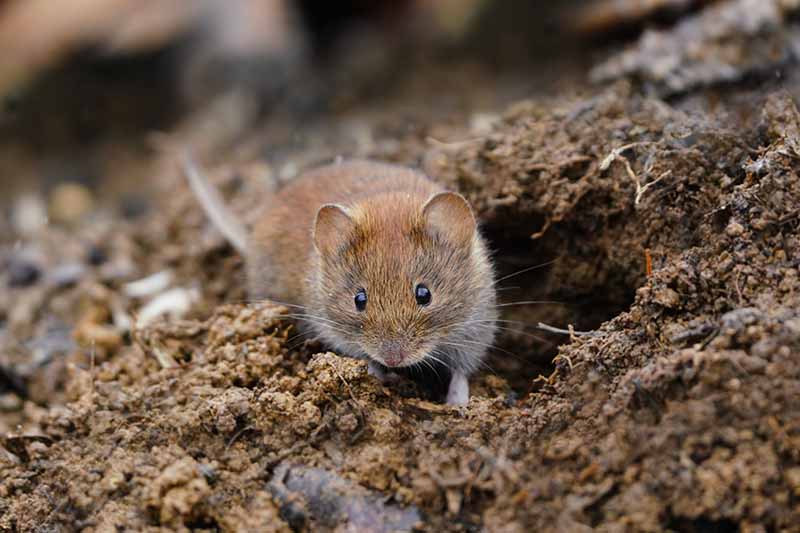
Voles will create little tunnels all around your yard, usually along walls and fences. Keep an eye out for the tunnels and for any mouse-like creatures lurking in your garden.
If your hostas suddenly collapse or wilt, try giving them a gentle pull. If they come out of the ground easily, it’s likely that a vole ate the roots.
You’ll need to take a multi-pronged approach to controlling these pests. Use a repellent around your hostas and other vulnerable plants.
A product like Bobbex-R can be sprayed at the entrance of the tunnels, and directly on plants.
If you’re battling voles or other critters in your garden, you might want to pick some up in ready-to-use quarts or a quart-size concentrate at Arbico Organics.
Voles like to have cover to hide under, so if you remove their hiding spots, they’ll be less inclined to visit.
Make sure to keep your garden free of debris and weeds, and you might want to trim up the lowest hosta leaves as well. Don’t use mulch in your garden, either.
If you have a serious problem, consider sinking wire mesh fencing 10 inches into the ground and extending it a foot above the earth surrounding your garden. Finally, you can buy traps that allow you to catch and release voles.
Insects and Gastropods
Hostas are one of the plants that I almost never have to worry about when it comes to pest problems. They are rarely troubled by the insects that can wreak havoc on other plants. However, there are two exceptions.
Cutworms
Young hostas are susceptible to cutworms, which are caterpillars in the Noctuidae family. Once they get a bit more mature, your plants aren’t in danger, but very young plants are susceptible.
You can protect young plants by creating barriers, handpicking cutworms when you see them, and encouraging or introducing beneficial predators like braconid and trichogramma wasps, and tachinid flies.
Cutworms aren’t incredibly common, however (unlike our next category of pests…).
For more help on identifying and eliminating cutworms, read our guide on these common pests.
Slugs and Snails
Ask any hosta grower and they’ll tell you, the biggest problem you’ll deal with (beyond hungry herbivores) is snails and slugs.
They love these plants, and they’ll decimate the leaves if they’re present in large enough numbers.
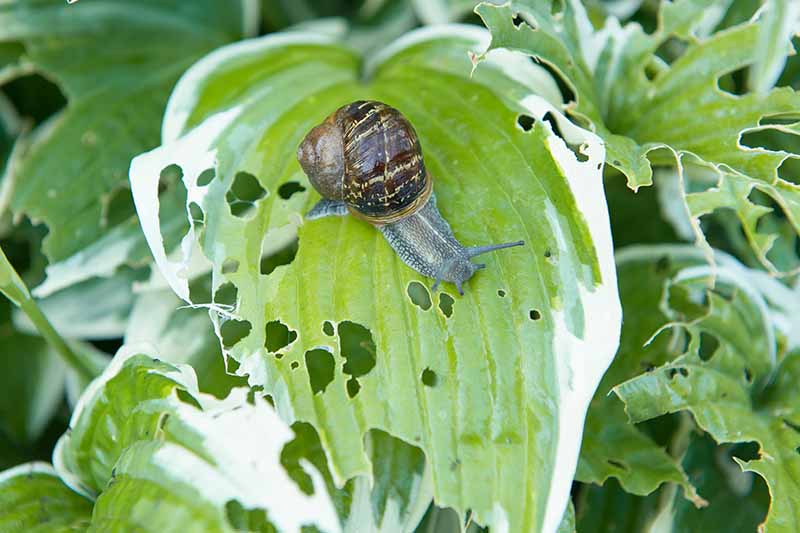
If your beautiful plants are beginning to look like Swiss cheese, then this is usually the problem.
There are chemical baits available to control slugs and snails, but these may be dangerous to wildlife and pets because they contain metaldehyde.
Instead, there are several nontoxic ways to control the night feeding slugs and snails. Our guide to slug control provides all the info you’ll need.
For added protection, ‘Love Pat,’ ‘Sum and Substance,’ ‘Ann Kulpa,’ and other varieties with waxy blue, thick, or heavily wrinkled leaves tend to be more slug resistant. But keep in mind, no variety is entirely slug-proof.
Find more tips on identifying and controlling hosta pests here.
Disease
As with pests, there aren’t too many diseases that trouble hostas. There are really just three main ones you might run up against.
Two are more common, while the third is not as widespread, but you should know what to look for anyway because it is making its way into more and more gardens.
Anthracnose
Anthracnose won’t usually kill your plants, but it’s unsightly. Caused by fungi in the Colletotrichum genus, the disease shows up as tan spots with dark borders on the foliage.
If the disease progresses, it can result in the spots that merge and eventually kill off some of the leaves.
Fungicides are only effective if you apply them preventively before symptoms are present, and this only helps to protect new foliage, so treating with fungicides isn’t a great option for home gardeners.
Instead, if you see the telltale spots, cut off the infected leaf. Then, be sure to water at the soil level, and water in the morning rather than the evening.
Hostas are pretty tough and should recover if you’re diligent about removing infected foliage.
Crown Rot
Sclerotium rolfsii and S. rolfsii var. delphinii cause a disease known as crown rot, stalk rot, southern blight, or white mold. It thrives in warm, moist conditions.
It causes the petioles (the stalks that attach the root to the leaf) to rot. This results in yellowed and wilted leaves, starting at the bottom of the plant.
As the disease progresses, the leaves will completely die off and the petiole will detach. If you examine the soil, you’ll see a white, web-like fungus spreading across the soil and the base.
Unfortunately, fungicides aren’t effective against this disease. That means the only solution is to pull infected plants.
Make sure to dig up all the roots, and scrape away the top inch of soil from around the plant. Dispose of everything in the garbage, not your compost pile.
Don’t grow any hostas or any other plants that can host this pathogen in the area for two years.
In the future, avoid overwatering, and make sure they get enough air circulation by spacing them at an appropriate distance.
You can also use products containing beneficial fungi in the Trichoderma genus and the bacteria Bacillus subtilis as a preventative soil treatment.
Superzyme Biological Growth Factor
Superzyme Biological Growth Factor contains both, and can be used as a soil soak and a foliar treatment to prevent fungal diseases.
Arbico Organics carries this treatment in packs of two 2.5-gallon containers.
Read more about identifying and treating crown rot in our guide.
Hosta Virus X
This disease isn’t widespread, but I want to mention it because it is becoming more common.
Hosta virus X (HVX) started spreading throughout the hosta world unintentionally, because the disease creates an interesting pattern on the leaves.
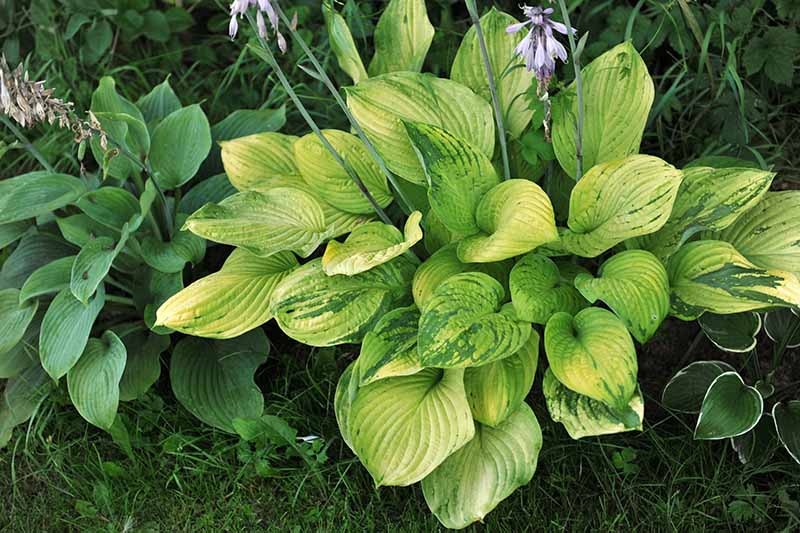
Hosta breeders propagated some plants that exhibited signs of this disease because they wanted to reproduce the interesting pattern – not knowing at the time that it was a disease symptom – and now it’s popping up in unintended places, in greater numbers.
Plants with this disease have mottled leaves, and you’ll often notice green or blue splotches and spots on golden or yellow foliage.
The virus is carried in the sap of the plant, which means if you come in contact with the sap while you’re working in the garden, you can spread it.
That’s why it’s always a good idea to clean your tools and hands in between working with different plants. This is especially true if your plants have any sort of mottling or variegation, since it could be the virus that’s causing the pattern.
If the variety you are growing isn’t meant to be mottled, or if your hosta develops new mottling and/or lumps, it’s likely infected. Pull it and dispose of it – again, in the garbage, not the compost pile, to prevent further spread.
Find more tips on hosta disease identification and control here.
Best Uses
Hostas obviously work well to add color to shady spots in the garden. That’s what they’re most famous for, after all! But don’t be afraid to get more creative.
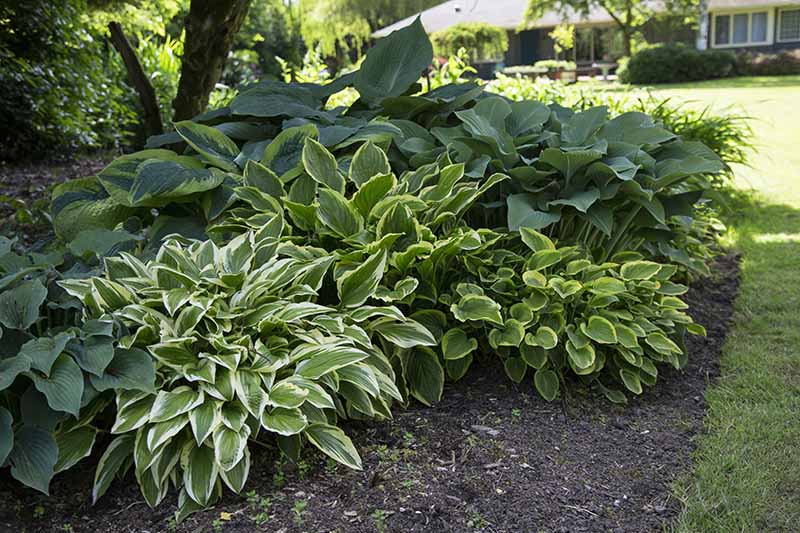
Have you ever heard of a moon garden? These are gardens that are designed to be enjoyed in the moonlight.
Varieties with white leaf edging or white variegation make a gorgeous addition to moon gardens because they seem to glow in the lunar evening light.
They also work as container plants, whether as a centerpiece of a group of various plants, or singly. Small varieties make good ground covers in groups, while larger ones act as attractive focal points in a shady spot.
Plant where they can hide fading spring bulbs, since they leaf out just as spring bulbs are dying back.

They’re also lovely as part of a cutting garden. The leaves make a beautiful addition to cut arrangements, as do the flowers.
If you have a fragrant flowering variety, plant them in containers, or near walkways or patios, so you can enjoy the scent.
Finally, put them in borders or as an accent to plants such as roses, which can benefit from a decorative companion to enjoy when they’re not blooming.
Quick Reference Growing Guide
| Plant Type: | Herbaceous perennial | Flower / Foliage Color: | White, pink, lavender, purple, red, yellow/green, blue-green, gold, yellow, cream, variegated, white |
| Native to: | China, Korea, Japan | Tolerance: | Shade |
| Hardiness (USDA Zone): | 2-8 | Soil Type: | Loamy, rich |
| Bloom Time: | Early summer-fall | Soil pH: | 6.5-7.5 |
| Exposure: | Full shade to part shade | Soil Drainage: | Well-draining |
| Spacing: | Depends on type | Attracts: | Bees, hummingbirds (flowers) |
| Planting Depth: | Same level as soil in container | Companion Planting: | Astilbe, crocus, daffodil, fern, hellebore, snakeroot, snowdrop, trillium, tulip |
| Time to Maturity: | 4-8 years | Avoid Planting With: | Coneflower, daylily, hollyhock, lavender, peony, Russian sage, verbena |
| Height: | Up to 10 feet | Uses: | Beds, borders, containers |
| Spread: | Up to 8 feet | Family: | Asparagaceae |
| Water Needs: | Moderate | Genus: | Hosta |
| Maintenance: | Low | Species: | Atropurpurea, capitata, clausa, densa, fluctuans, gracillima, hypoleuca, kikutii, laevigata, longipes, longissima, montana, nakaiana, nigrescens, pachyscapa, plantaginea, pycnophylla, rupifraga, sieboldiana, sieboldii, tardiva, ventricosa, ventusa, yingeri |
| Common Pests: | Deer, rabbits, squirrels, voles; Cutworms, root knot nematodes, slugs, snails | Common Diseases: | Anthracnose, bacterial soft rot, crown rot, fusarium wilt, hosta virus X |
Hostas Are Easy to Love
Hostas are long-lived, hardy, and reliable. Plus, they can adapt to a range of conditions. Add to that the fact that there are so many different species and cultivars available, and it’s no wonder they’re so incredibly popular.
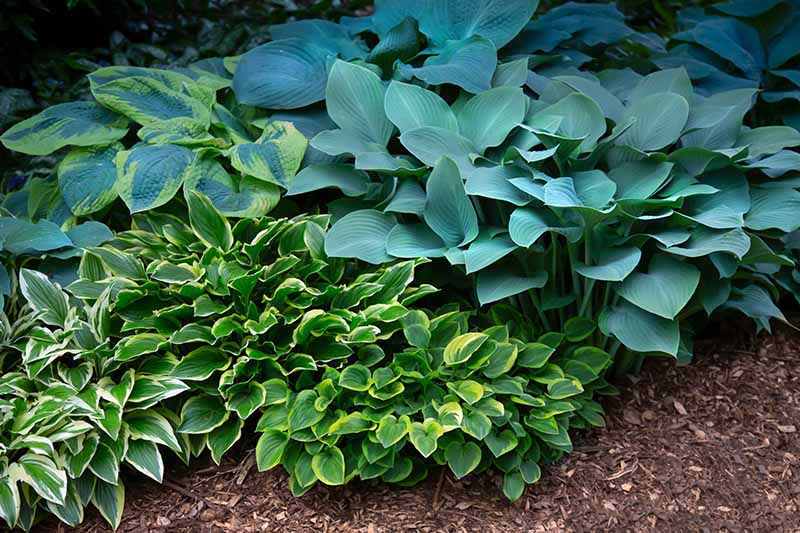
We can’t wait to hear about which species, hybrids, or cultivars you end up with. There are so many to choose from! Be sure to come back and tell us all about your new garden pals in the comments section below.
While you’re here, if this guide gave you the info you were looking for, we have many other informative articles that can help you add even more beautiful foliage to your garden, beginning with these:

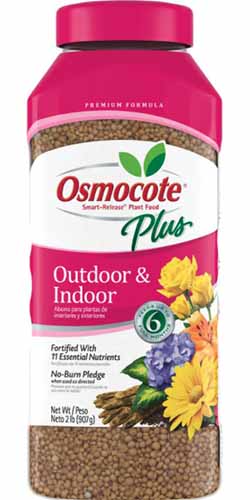

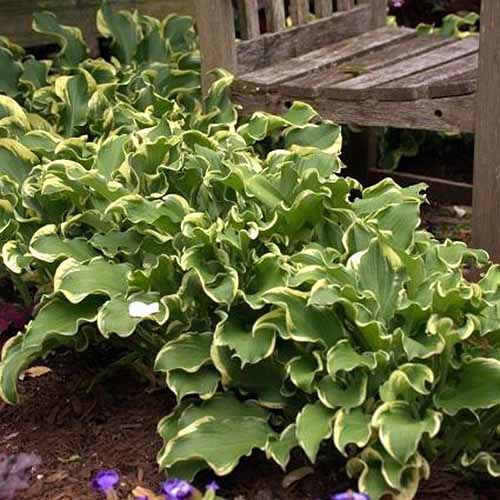

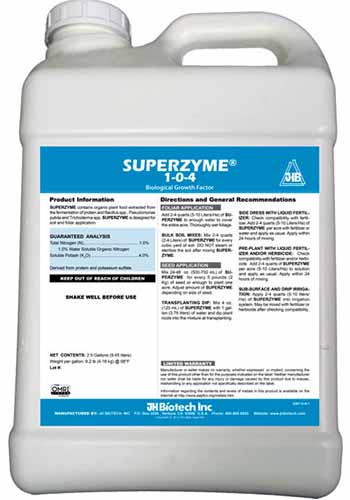
Love hostas, reading the article I discovered I was about to fail planting under oak trees. I will need to dig down 12 inches or raise with a stone wall. Now if I can find some diagram that show various designs with hosta plants